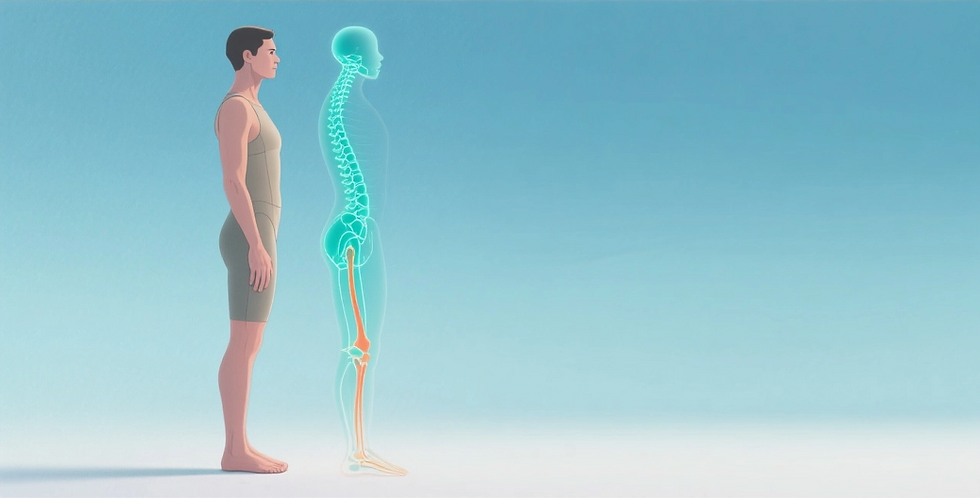Why Conventional Posture Correction Doesn’t Work (And What to Do Instead)
- Luc

- Jan 11
- 5 min read
Updated: Feb 3
Have you ever tried stretching, strengthening exercises, or even expensive gadgets to fix your posture, only to feel like nothing really changes? You’re not alone. Most people approach posture correction the wrong way—focusing only on the muscles and joints. But here’s the truth: your posture is controlled by your brain, not just your body.
Let me explain.
The Real Cause of Poor Posture
Your body’s alignment isn’t just about tight muscles or weak core strength. It’s about how your brain interprets signals from your body. These signals come from three key areas:
Your feet: They tell your brain how you’re standing and balancing.
Your eyes: They help your brain understand where you are in space.
Your jaw: It’s connected to your head and neck, influencing your posture more than you might think.
When these signals are distorted—due to stress, injuries, or even bad habits—your brain creates compensations. These compensations lock your body into patterns of tension and misalignment. Over time, this becomes your “normal,” and no amount of stretching or strengthening will fix it.
Why Conventional Treatments Fall Short
Most conventional posture treatments focus on the symptoms, not the cause.
Stretching might temporarily loosen tight muscles, but it doesn’t address why they’re tight in the first place.
Strengthening exercises can help, but if your brain is still misinterpreting signals, your body will keep falling back into the same patterns.
This is why so many people feel stuck, even after months of effort. The root cause—how your brain processes sensory input—remains unaddressed.
A Smarter Way to Fix Your Posture
To truly correct your posture, you need to retrain your brain. By improving the sensory feedback from your feet, eyes, and jaw, you can help your brain map your body correctly in space. This allows your muscles to relax, your tension to release, and your posture to naturally improve.
Here’s how I do it:
Feet: I use Therapeutic Insoles , which are designed to stimulate the sensory nerves in the feet. These insoles help the brain process feedback from the feet more accurately, improving balance and alignment.
Eyes: I implement simple but effective eye exercises with Saccade Training to improve visual tracking and focus. These exercises help the brain better understand where the body is in space.
Jaw: Releasing tension in the jaw can have a surprising impact on the head, neck, and overall alignment.
When you address these areas, you’re not just treating the symptoms—you’re fixing the root cause.
How I Measure Progress: The Romberg Test and One-Leg Stand Test
To track changes in posture and balance, I use two simple tests: the Romberg test and the one-leg stand test. These tests help me assess how well the brain is processing sensory input and how much improvement has been made.
The Romberg Test:
Stand with your feet together and arms by your sides.
Close your eyes and try to maintain your balance for 30 seconds.
Pay attention to how steady you feel—do you sway, or do you feel stable?
Many people struggle to stay balanced during the Romberg test before starting brain-based posture correction. After using Posturepro Therapeutic insoles and practicing eye exercises with Saccade Training, I often see dramatic improvements in their stability.
The One-Leg Stand Test:
Stand on one leg with your eyes open and arms by your sides.
Time how long you can hold the position without losing balance.
Repeat the test after using the insoles or doing eye exercises to compare the results.
This test is a great way to measure how well your brain is integrating sensory feedback from your feet. Most clients notice an immediate improvement in their ability to balance on one leg after just a few minutes of using the insoles or doing the exercises.
My Experience with Brain-Based Posture Correction
I’ve been helping people improve their posture using this brain-based approach for almost five years. And here’s what I’ve learned: it works.
9 out of 10 people who come to me have already tried conventional treatments. They’ve stretched, strengthened, and even bought expensive posture gadgets, but they’re still stuck. Once we start working on retraining their brain, they finally see lasting results.
One of the most effective tools I’ve found is Posturepro Therapeutic insoles. These insoles stimulate the sensory nerves in the feet, helping the brain process feedback more accurately. Combined with eye exercises and regular use of the Romberg test and one-leg stand test to track progress, the results are incredible.
For example, one client came to me with chronic neck and shoulder tension that had persisted for years. After just a few weeks of using the insoles, practicing eye exercises, and improving her balance on both tests, her posture improved dramatically. Not only did her tension disappear, but she also felt more balanced and confident in her movements.
How You Can Get Started
If you’re tired of temporary fixes and want to address the root cause of your posture issues, here are a few simple steps to try:
Try Sensory Insoles: Insoles like Therapeutic Insoles can help improve the feedback your brain receives from your feet.
Practice Eye Exercises: Spend a few minutes each day focusing on objects at different distances or practicing smooth eye movements.
Relax Your Jaw: Gently massage your jaw or practice deep breathing to release tension.
Test Your Progress: Use the Romberg test and one-leg stand test to track changes in your balance over time.
Ready to Take the Next Step?
If you’re ready to break free from chronic misalignment and discover a smarter way to improve your posture, I’d love to help you.
Schedule a free 15-minute Healing & Growth Discovery Call to:
Discuss your posture challenges.
Learn how brain-based posture correction can work for you.
Get personalized tips to start your journey toward better alignment and balance.
Click below to book your call:👉

The Bottom Line
Your posture isn’t just about your muscles—it’s about how your brain interprets signals from your body. By improving sensory feedback from your feet, eyes, and jaw, you can retrain your brain, release tension, and restore balance.
If you’ve been stuck in the cycle of conventional treatments, it’s time to try something different. A brain-based approach to posture correction, using tools like 9 Hertz insoles, eye exercises, and simple balance tests, could be the lasting solution you’ve been looking for.
Disclaimer
This blog is for informational purposes only and is not intended as medical advice. It is meant to complement other health and wellness methods, not replace professional medical care. By implementing the suggestions in this blog, you acknowledge that you are doing so voluntarily and take full responsibility for your health and well-being. Always consult a healthcare professional before starting any new health or posture correction program.





Comments